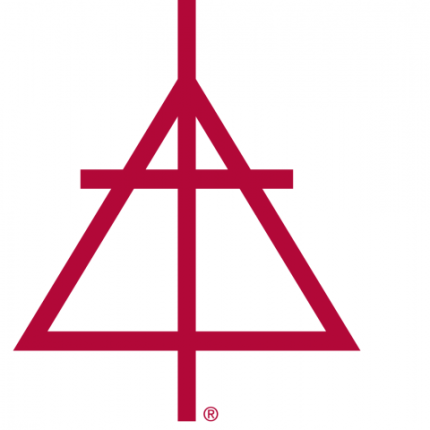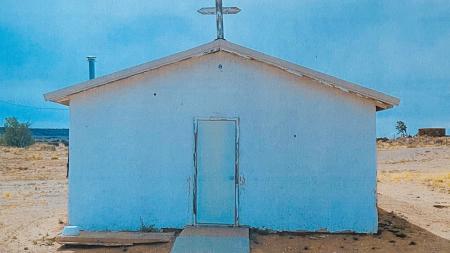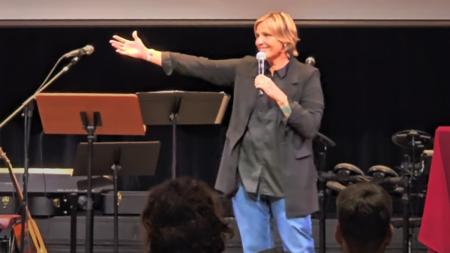CRC Logo Hits 50

While cleaning out old files on her computer system earlier this year, an employee at the Christian Reformed Church in North America offices in Grand Rapids, Mich., came across an interesting 2014 email.
The email had been sent by a relative of the now-deceased designer of the CRC logo. The relative had seen the familiar logo of a cross superimposed on a triangle on a sign in California and wondered if the organization advertising on the sign was affiliated with the denomination.
While the original email had been responded to back in 2014, it had been tucked away in an email file folder. The employee passed it along to Dean Heetderks, codirector of the CRC’s Ministry Support Services, to see if he was interested in archiving it.
“I have copies of older proposed designs for a CRC logo, but had nothing on file for who designed the current logo — or when. This was a good lead,” said Heetderks.
The writer of the email knew the logo had to have been designed between 1964 and 1970.
“With help from Heritage Hall [CRC Archives] staff, we found a July 12, 1968, Banner article on news from Synod 1968 reporting on the approval of the logo and the instruction to have it trademarked,” said Heetderks. “That makes our beloved 'trailer hitch' logo 50 years old this year.”
The story of the logo goes back to at least 1957, when the Banner used a seal to commemorate the CRC’s 100th anniversary. It was recommended that Synod 1958 adopt this as an official denominational seal, but that idea was rejected and a committee was appointed to come up with another design.
In 1960, the committee brought a proposed design to synod, which gave tentative approval, pending reaction from the broader church.
That symbol combined the shape and color of a cathedral window encircled by a victor’s wreath symbolizing God’s never-ending love. Other proposed symbols included an image of the tablets of the law of Moses, a cross, a globe representing the Great Commission, and a hand holding a burning heart (an adaptation of the seal of John Calvin, on which the seal of Calvin College is based).
When it became clear that the broader church didn’t necessarily like the symbol suggested at Synod 1960, the committee continued its work for several years, presenting another proposed seal to Synod 1967.
The elements in that seal included a circle symbolizing eternity with a tulip in the center, a reference to the “five points of Calvinism” elaborated by the Synod of Dordrecht. The first letters of these five points — total depravity, unconditional election, limited atonement, irresistible grace, and perseverance of the saints — spell “tulip.”
Synod 1967 rejected this proposed seal. A new committee was appointed, and it came up with the current “cross and triangle” logo, presenting it to Synod 1968. Suitable for use on a wide range of materials, the logo was designed by David Vander Veen, a Grand Rapids artist and designer who served on the 1967-appointed committee.
Synod 1968 said of the new symbol, “Its simplicity creates a distinctive and memorable emblem. . . . It can be reproduced in any size or texture. . . . Its capacity for communication is not limited by use of words. . . . Its design represents essential elements of our faith” (Acts of Synod 1968, p. 28).
Besides Vander Veen, then vice president and principal of the Grand Rapids advertising firm, Stevens Advertising, Inc., the denominational seal committee included Dick Van Halsema and William Doezema.
Members of the committee gave this description to synod delegates: “The design committee feels that perhaps what is most beautiful about the emblem is the equality that freely permits each of us to see in it what we find meaningful about our faith and church.”
Fifty years later, the logo has become well known as a symbol for the Christian Reformed Church in North America denomination. This trademarked logo is used by many congregations on their church signs and in their materials. It is also used by CRCNA ministries to help denote their official status as an agency of the denomination.
“One of the first ways that people will identify something as being part of the Christian Reformed Church in North America is through the cross and triangle that make up the CRCNA logo,” explains the CRCNA Brand StandardsGuide.
“The triangle represents the Trinity, our belief in one God we know as three persons: Father, Son, and Holy Spirit. The cross symbolizes our belief in Jesus Christ’s sacrificial death for our salvation. Symbols like these are immensely powerful tools that can become an invaluable asset to a denomination in building up its brand recognition and reputation.”


